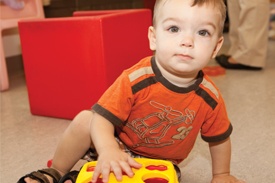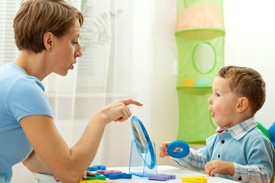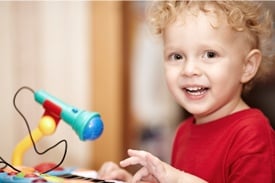Experts recommend you read to your child as often as you can and that you strive to have at least one scheduled reading time each day. Choosing regular times to read (especially before naps and bedtime) is a way to help your child learn to sit with a book and relax. But you can read anytime your child seems in the mood.
If your toddler will let you, hold him or her in your lap when you read. It's a great spot for:
When and How Should I Read to My Child?
Tags: Speech, Language, Communication, literacy, Learning, Voice, toddler, talking
The Stages of Infant Speech Development
Children begin developing speech as an infant. By 6 months, babies coo and play with their voices by producing sounds such as "oo," "uh," "mm," "da," and "goo." Children learn speech by imitating the sounds they hear. Actions such talking about what you are doing during the day, singing songs and reading books expose your child to a variety of sounds that he or she will begin imitating.
Tags: Speech, Language, Communication, Voice, talking
Can You Understand Your Child's Speech?
It’s common for most children to make some mistakes as they learn to say new words. Different sounds are mastered at different ages. Consistent, correct sound production will vary from child to child. When mistakes continue past a certain age, that’s when it's considered a speech sound disorder. Speech sound disorders include problems with articulation (pronouncing sounds correctly) and phonological processes (errors with sound patterns).
Tags: Speech, Language, Communication, Voice, toddler, talking
Why Should I Read to My Toddler?
Reading aloud is an important way to help your child make the transition from infancy into their toddler years. Between the ages of 1 and 3, your child will have triumphs and challenges. Studies show that children with an active exposure to language have social and educational advantages over their peers - and reading is one of the best ways to expose your child to language.
Tags: Speech, Language, Communication, reading, literacy, Learning, toddler
How Hearing Loss Affects Speech-Language Development
Children learn to talk by listening to those around them. The first few years of life are a critical time for speech and language development. Children must be able to hear speech clearly in order to learn language. Fluctuating hearing loss due to repeated ear infections might mean the child doesn't hear consistently and may be missing out on critical speech information. Permanent hearing loss will also affect speech and language development, especially if it is not detected early. The earlier hearing loss is identified and treated, the more likely the child will develop speech and language skills on par with children who aren’t experiencing hearing issues.
Tags: Speech, Hearing Aid, Hearing Aids, Communication, Hearing, Deaf, Hard of Hearing, Hearing Loss, Learning, Voice, toddler, talking
Should My Child Learn a Second Language?
Introducing your child to multiple languages at a young age is a personal decision that can be challenging for many families. Children who become fluent in one language are referred to as “monolingual,” and children who become fluent in two languages are referred to as “bilingual.” Speaking a language at home that is different than what your child may be exposed to at school and in the community can spark several questions such as “Will it be difficult for my child to learn another language?” “When should I start to teach my child two languages?” “How can I help my child learn a second language if I don’t know it myself?”
Are Speech Disorders Inherited?
Evidence exists linking genetic factors to a variety of speech and language difficulties. Recent studies of molecular genetics and neuroimaging are cross-disciplinary, combining forces between speech-language pathologists, physicians, and scientists. Researchers have already identified over 400 genes linked to hearing loss, and ongoing studies investigate genetic links to stuttering, voice disorders, and language disorders.
Tags: Speech, Language, Communication, Stuttering, talking
Benefits of Lullabies for Babies
Tags: Language, Communication, Hearing
How Sensory Play Helps Developmental Skills
Imagine a cool, fall day. The windows are open and a light breeze is coming through from the lake. As the breeze comes in, you begin to smell a cinnamon apple pie baking in the oven, just like your grandmother would make.
Tags: Speech, Communication, Learning, toddler, talking
How to Prepare for an Upcoming Speech-Language Evaluation
A speech and language evaluation is a normal avenue to pursue when parents or caregivers suspect difficulty with communication. Anticipation of a speech and language evaluation can bring on feelings of stress if you aren’t sure what to expect, and meeting a new health-care professional in an unfamiliar office space can be overwhelming.
Tags: Speech, Language, Communication, Teens, Voice, toddler, talking


















